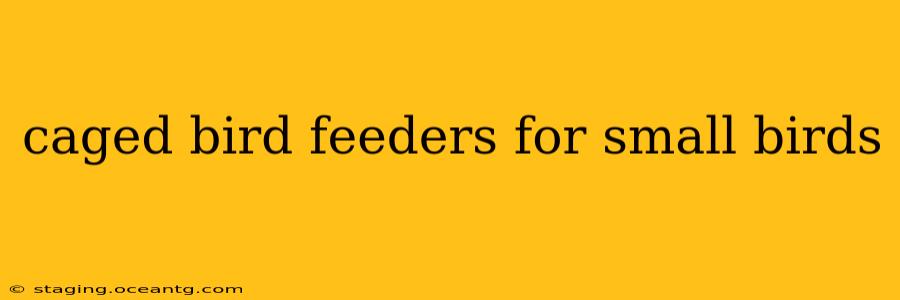Choosing the right bird feeder can significantly impact the types of birds you attract to your garden. For smaller birds like finches, chickadees, and hummingbirds, a caged feeder offers several advantages, primarily protecting the food from larger, more aggressive birds and keeping it clean and dry. This comprehensive guide explores the benefits, types, and considerations when choosing a caged bird feeder for your feathered friends.
What are the Benefits of Using a Caged Bird Feeder?
Caged feeders, also known as mesh feeders or tube feeders with cages, provide several key benefits that make them ideal for smaller birds:
-
Protection from Bullies: Larger birds like starlings, grackles, and squirrels can dominate traditional feeders, leaving smaller birds with little to eat. The cage acts as a barrier, allowing only smaller birds to access the food.
-
Keeps Food Clean and Dry: The cage helps shield the seed from rain and snow, preventing it from molding or becoming soggy. This ensures the food remains fresh and palatable for your smaller bird visitors.
-
Reduced Food Waste: Because the food is protected, there's less chance of it being scattered or wasted on the ground. This is particularly beneficial if you're using more expensive seed mixes.
-
Variety of Designs: Caged feeders come in a variety of styles, sizes, and materials to suit different preferences and bird species.
What Types of Caged Bird Feeders are Available?
Several types of caged feeders cater to different needs and bird preferences:
-
Mesh Feeders: These feeders consist of a wire mesh cage surrounding a tray or platform where seeds are placed. They're simple, easy to clean, and offer good visibility of the birds feeding.
-
Tube Feeders with Cages: These combine the benefits of a tube feeder (which often dispenses seeds more efficiently) with the protective cage. The seeds are usually dispensed through small holes in the tube, again preventing larger birds from accessing them.
-
Suet Cages: Some caged feeders are designed specifically for suet, a high-energy food source popular with many bird species. These cages often have multiple perches to accommodate several birds at once.
What Size and Type of Seed is Best for Small Birds?
The size and type of seed you choose will heavily influence which birds you attract. Smaller seeds are generally preferred by smaller birds. Popular choices include:
-
Nyjer (thistle) seed: A small, oil-rich seed favored by goldfinches and other small finches. It's best served in a specialized feeder with small ports.
-
Sunflower seeds (small): Smaller sunflower seeds are readily consumed by a wide variety of small birds.
-
Millet: A less expensive seed that attracts various small birds, but is also enjoyed by larger birds.
How Do I Clean a Caged Bird Feeder?
Regular cleaning is crucial to prevent the spread of disease among your feathered friends. Follow these guidelines:
-
Frequency: Clean your feeder at least once a month, or more frequently if you notice mold or droppings accumulating.
-
Cleaning Solution: Use a mild solution of soap and water. Avoid harsh chemicals that could harm birds.
-
Drying: Thoroughly rinse and dry the feeder before refilling it with seed. Allow it to air dry completely in the sun if possible.
What are Some Popular Caged Bird Feeder Brands?
While I cannot endorse specific brands, a quick online search for "caged bird feeders" will reveal many reputable manufacturers offering high-quality products. Consider reading reviews before making a purchase to ensure you're getting a durable and effective feeder.
How Often Should I Refill My Caged Bird Feeder?
The frequency of refilling depends on the size of the feeder, the number of birds visiting, and the type of seed used. Monitor your feeder regularly and refill it as needed to keep a consistent supply of food for your birds.
Where is the Best Place to Hang a Caged Bird Feeder?
Placement is key for maximizing the feeder's effectiveness and safety. Consider these factors:
-
Location: Hang the feeder in a visible location, away from dense vegetation that could hide predators.
-
Height: Position the feeder at a height that's easily accessible to smaller birds but out of reach of cats and other ground predators.
-
Shelter: Ideally, place the feeder in a location that offers some protection from the elements, such as under a tree overhang or eave.
By carefully considering the points outlined in this guide, you can choose and maintain a caged bird feeder that attracts and supports a thriving population of small birds in your backyard. Remember, responsible bird feeding contributes to the health and well-being of local bird populations, enriching your outdoor experience.
